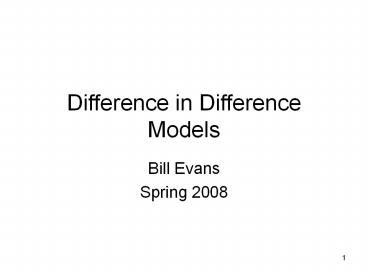Difference in Difference Models PowerPoint PPT Presentation
Title: Difference in Difference Models
1
Difference in Difference Models
- Bill Evans
- Spring 2008
2
Difference in difference models
- Maybe the most popular identification strategy in
applied work today - Attempts to mimic random assignment with
treatment and comparison sample - Application of two-way fixed effects model
3
Problem set up
- Cross-sectional and time series data
- One group is treated with intervention
- Have pre-post data for group receiving
intervention - Can examine time-series changes but, unsure how
much of the change is due to secular changes
4
Y
True effect Yt2-Yt1
Estimated effect Yb-Ya
Yt1
Ya
Yb
Yt2
ti
t1
t2
time
5
- Intervention occurs at time period t1
- True effect of law
- Ya Yb
- Only have data at t1 and t2
- If using time series, estimate Yt1 Yt2
- Solution?
6
Difference in difference models
- Basic two-way fixed effects model
- Cross section and time fixed effects
- Use time series of untreated group to establish
what would have occurred in the absence of the
intervention - Key concept can control for the fact that the
intervention is more likely in some types of
states
7
Three different presentations
- Tabular
- Graphical
- Regression equation
8
Difference in Difference
Before Change After Change Difference
Group 1 (Treat) Yt1 Yt2 ?Yt Yt2-Yt1
Group 2 (Control) Yc1 Yc2 ?Yc Yc2-Yc1
Difference ??Y ?Yt ?Yc
9
Y
Treatment effect (Yt2-Yt1) (Yc2-Yc1)
Yc1
Yt1
Yc2
Yt2
control
treatment
t1
t2
time
10
Key Assumption
- Control group identifies the time path of
outcomes that would have happened in the absence
of the treatment - In this example, Y falls by Yc2-Yc1 even without
the intervention - Note that underlying levels of outcomes are not
important (return to this in the regression
equation)
11
Y
Yc1
Treatment effect (Yt2-Yt1) (Yc2-Yc1)
Yc2
Yt1
control
Treatment Effect
Yt2
treatment
t1
t2
time
12
- In contrast, what is key is that the time trends
in the absence of the intervention are the same
in both groups - If the intervention occurs in an area with a
different trend, will under/over state the
treatment effect - In this example, suppose intervention occurs in
area with faster falling Y
13
Y
Estimated treatment
Yc1
Yt1
Yc2
control
True treatment effect
Yt2
True Treatment Effect
treatment
t1
t2
time
14
Basic Econometric Model
- Data varies by
- state (i)
- time (t)
- Outcome is Yit
- Only two periods
- Intervention will occur in a group of
observations (e.g. states, firms, etc.)
15
- Three key variables
- Tit 1 if obs i belongs in the state that will
eventually be treated - Ait 1 in the periods when treatment occurs
- TitAit -- interaction term, treatment states
after the intervention - Yit ß0 ß1Tit ß2Ait ß3TitAit eit
16
Yit ß0 ß1Tit ß2Ait ß3TitAit eit
Before Change After Change Difference
Group 1 (Treat) ß0 ß1 ß0 ß1 ß2 ß3 ?Yt ß2 ß3
Group 2 (Control) ß0 ß0 ß2 ?Yc ß2
Difference ??Y ß3
17
More general model
- Data varies by
- state (i)
- time (t)
- Outcome is Yit
- Many periods
- Intervention will occur in a group of states but
at a variety of times
18
- ui is a state effect
- vt is a complete set of year (time) effects
- Analysis of covariance model
- Yit ß0 ß3 TitAit ui ?t eit
19
What is nice about the model
- Suppose interventions are not random but
systematic - Occur in states with higher or lower average Y
- Occur in time periods with different Ys
- This is captured by the inclusion of the
state/time effects allows covariance between - ui and TitAit
- ?t and TitAit
20
- Group effects
- Capture differences across groups that are
constant over time - Year effects
- Capture differences over time that are common to
all groups

